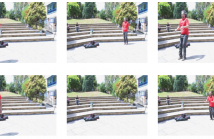- Read more about EXTRACTING KEY FRAMES FROM FIRST-PERSON VIDEOS IN THE COMMON SPACE OF MULTIPLE SENSORS
- Log in to post comments
Selecting authentic scenes about activities of daily living (ADL) is useful to support our memory of everyday life. Key-frame extraction for first-person vision (FPV) videos is a core technology to realize such memory assistant. However, most existing key-frame extraction methods have mainly focused on stable scenes not related to ADL and only used visual signals of the image sequence even though the activities usually associate with our visual experience. To deal with dynamically changing scenes of FPV about daily activities, integrating motion and visual signals are essential.
- Categories:
 4 Views
4 ViewsThis work addresses image recovery problem in the presence of salt-and-pepper noise and image blur. The salt-and-pepper noise reviewed as the impulsive noise, in this paper, is modeled as a sparse signal because of its impulsiveness. To accurately reconstruct the clean image and the blur kernel, the framelet domains are exploited to sparsely represent the image and the blur kernel. From the reformulations conducted, a joint estimation is devised to simultaneously perform the image recovery, the salt-and-pepper noise suppression and the blur kernel estimation under a optimization framework.
- Categories:
 2 Views
2 Views- Read more about How should we evaluate supervised hashing?
- Log in to post comments
- Categories:
 13 Views
13 Views
- Read more about Summarization of Human Activity Videos Via Low-Rank Approximation
- Log in to post comments
Summarization of videos depicting human activities is a timely problem with important applications, e.g., in the domains of surveillance or film/TV production, that steadily becomes more relevant. Research on video summarization has mainly relied on global clustering or local (frame-by-frame) saliency methods to provide automated algorithmic
- Categories:
 1 Views
1 Views
- Read more about Summarization of Human Activity Videos Via Low-Rank Approximation
- Log in to post comments
Summarization of videos depicting human activities is a timely problem with important applications, e.g., in the domains of surveillance or film/TV production, that steadily becomes more relevant. Research on video summarization has mainly relied on global clustering or local (frame-by-frame) saliency methods to provide automated algorithmic
- Categories:
 1 Views
1 Views
- Read more about Summarization of Human Activity Videos Via Low-Rank Approximation
- Log in to post comments
Summarization of videos depicting human activities is a timely problem with important applications, e.g., in the domains of surveillance or film/TV production, that steadily becomes more relevant. Research on video summarization has mainly relied on global clustering or local (frame-by-frame) saliency methods to provide automated algorithmic
- Categories:
 2 Views
2 Views
- Read more about Summarization of Human Activity Videos Via Low-Rank Approximation
- Log in to post comments
Summarization of videos depicting human activities is a timely problem with important applications, e.g., in the domains of surveillance or film/TV production, that steadily becomes more relevant. Research on video summarization has mainly relied on global clustering or local (frame-by-frame) saliency methods to provide automated algorithmic
- Categories:
 2 Views
2 Views
- Read more about Summarization of Human Activity Videos Via Low-Rank Approximation
- Log in to post comments
Summarization of videos depicting human activities is a timely problem with important applications, e.g., in the domains of surveillance or film/TV production, that steadily becomes more relevant. Research on video summarization has mainly relied on global clustering or local (frame-by-frame) saliency methods to provide automated algorithmic
- Categories:
 9 Views
9 Views- Read more about EDITED FILM ALIGNMENT VIA SELECTIVE HOUGH TRANSFORM AND ACCURATE TEMPLATE MATCHING
- Log in to post comments
Edited film alignment is the post-production process of finding small parts of unedited footage that temporally and spatially match an edited film. The huge amount of data to be processed makes significant downsampling of the videos essential in real-life applications. Simultaneously, professional users demand that the task be achieved with frame and pixel-level accuracy. We propose a novel selective Hough transform (SHT) and an accurate template matching method to address the difficult trade-off between accuracy and scalability.
- Categories:
 23 Views
23 Views